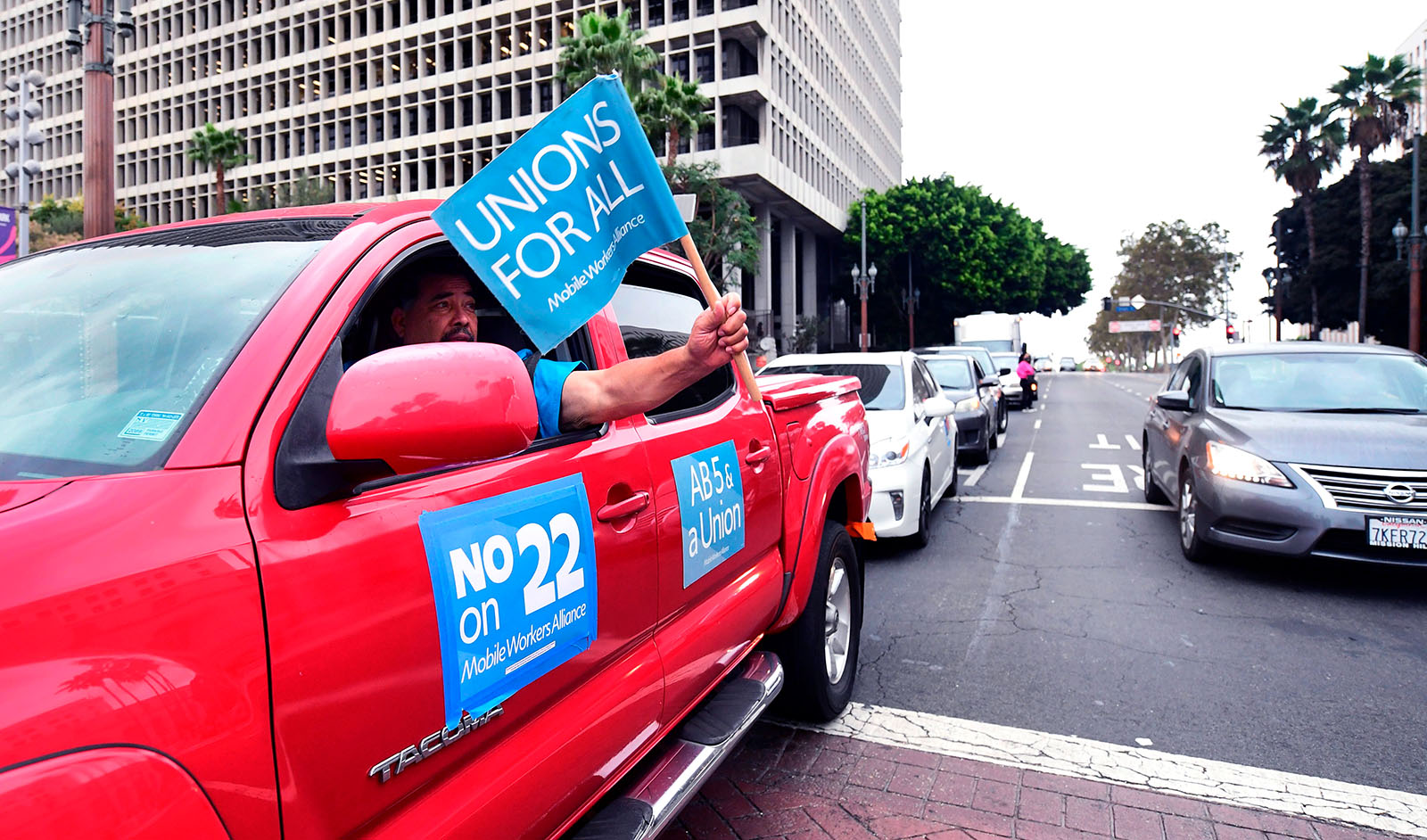Is Organized Labor Making a Comeback? Part 2

App-based drivers from Uber and Lyft protest in front of City Hall in Los Angeles on October 22, 2020. We've got all these workers that are largely misclassified as independent contractors, so-called gig workers, and there are fierce debates about them around the world.
Photo: Frederic J. Brown/AFP via Getty Images
In the second of our pieces this week about the rise of organized labor in the U.S., we spoke to Robert Bruno, professor of Labor and Employment Relations at the University of Illinois’ School of Labor and Employment Relations, about what impact the new U.S. administration might have.
President Joe Biden is seen as one of the most pro-labor presidents in decades and wants to make it easier for employees to join a union. Yet only about 10% of the American workforce is currently in a union. You can read the first piece here.
BRUNO: The House of Representatives recently passed the PRO Act, which strengthens American workers’ right to organize. If that were to find its way to President Biden’s desk, it would make a significant difference in the relationship between labor and capital. Maybe as great a change as the passage of the national labor relations act of 1935.
The act would address a lot of the inequities that worker advocates have pointed to and that a lot of social science research supports, and therefore, one would expect to see increased levels of organization and unionization.
The Right to Organize
BRINK: What are the main points of the proposed legislation?
BRUNO: The act would largely return the law and the role of the federal government to that of one that supports workers’ rights to organize.
As it’s currently practiced, it’s the employer that really chooses the mode by which workers organize themselves into a union. An employer can recognize a group of workers as consenting to being in a union through a majority showing on the part of those workers, like signatures on a petition or some communication to the employer.
The employer can voluntarily choose to accept the will of the employees, but most employers don’t do that because they don’t really want a union in the workplace, and so they compel an election. And under the national labor relations board regulations, there’s a whole series of things that can happen between the date on which an election is set and when the vote is cast, and the rules for carrying out the election greatly favor the employer.
What the PRO Act would do is remove the employer from the election procedure and prohibit anti-union employer practices. For example, currently employers can require their employees to attend “captive audience” meetings where the employer is free to condemn the union without the union having a right to respond.
Under the act, the decision would be internal among the workers, and the employer would not be able to use the election process to influence the will of the workers.
There are a number of states that have provisions for allowing public sector workers to gain unionization by simply showing that a majority of workers have selected to be represented by a union. No election is needed. Illinois is an example of such a state. And wherever this occurs, you see higher rates of unionization.
In 2007, the Employee Free Choice Act, which would have allowed for “card check” union recognition was passed in the U.S. House but never came up for a vote in the Senate because of the threat of a Republican filibuster. The PRO Act doesn’t go that far, but it helps to return the election process to the workers. So that’s number one.
While younger workers do have a positive view of organized labor, they’re not so certain that in its current shape and current form, it’s the right kind of worker organization for them.
Expanding the Coverage of Labor Law
Number two, the bill expands the scope of coverage of labor laws. At the moment, we’ve got all these workers that are largely misclassified as independent contractors, so-called gig workers, and there are fierce debates about them around the world. In the U.K., most recently, a court ruled that Uber drivers should be classified as employees and not independent contractors.
Right now, in the U.S., they’re outside of the protections of the National Labor Relations Act. They’re not covered under labor and employment law. If they were classified as employees, they would fit under the coverage of that law and would have rights to organize. As employees, they would also have access to minimum wage law protections and other employer paid benefits.
BRINK: We’ve obviously seen a lot of talk recently about diversity issues, Black Lives Matter, and so forth. Do you think that kind of employee activism is likely to translate into more organized labor?
BRUNO: There is plenty of survey research that indicates that younger workers are really in tune to what you would call social justice in the workplace. Their advocacy is often driven by this sense of fair play and creating equitable environments. They want the same things that all workers want. They want better pay. They want better work opportunities, they want safe work environments, but they also see the employer as having a social obligation.
Polling also indicates that younger workers see the labor movement in a very positive way. They’re very supportive of the idea of the labor movement; they see it as speaking on behalf of those workers that have fewer resources.
Are Unions the Right Vehicle for Millennials?
The interesting aspect is that, while they do have a positive view of organized labor, they’re not so certain that in its current shape and current form, it’s the right kind of worker organization for them. They’re likely to vote in ways that are supportive of organized labor’s agenda, but they might not want to form a traditional labor union that bargains collective bargaining agreements, even though collective bargaining agreements are things they see as valuable.
They’re not certain that the current union structure is the one that is best for them because they may move from job to job and prefer to be part of a flatter institutional structure with less of a hierarchy of leadership. They also look at organized labor and see a leadership that’s largely much older than they are. They’re going to ask, “how diverse is that union? How do they treat people of color?” And as a result, they’re seeking out different kinds of advocacy groups.
BRINK: Do you think that unions will be able to adapt to that?
BRUNO: Great question. More than a decade ago, the AFL-CIO actually began to take a good hard look at this question, and they put their own task force together to address younger workers. This task force traveled around the country and met with young workers and went to a lot of college campuses.
A number of unions, as a result of this initiative, created their own caucuses that were focused on young workers, however they defined it. It’s about how you hold your meetings, where you hold your meetings, what are the topics of those meetings, the kinds of issues that you embrace, the kinds of driving concerns that are happening in civil society.
How Does the Stakeholder Conversation Help Unions?
BRINK: There’s a lot of talk of companies needing to take account of all stakeholders, including employees. Do you think that that’s a real shift that might impact this conversation?
BRUNO: This period under COVID has revealed a lot of inequity, but I don’t think the actual practices have changed in any significant way, because I don’t know if capital is going to respond differently to the structural incentives that are in the system. It’s great if people act in humane and ethical ways, but the incentive is still to attain greater shares of wealth for shareholders.
Right now, capital defines what work is and as a result, who the worker is. And so unless workers have the power to push back, it’s largely rhetorical. I’m not making a judgment on the ethical position of those CEOs. They may genuinely feel that there should be a broader embrace of the community, but if you look really closely at what the incentives are, capital is going to do what capital is going to do, unless it’s compelled to do otherwise.




